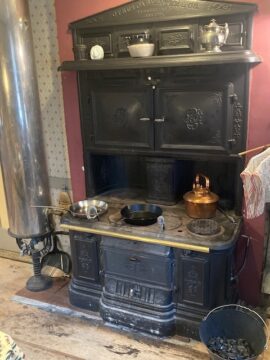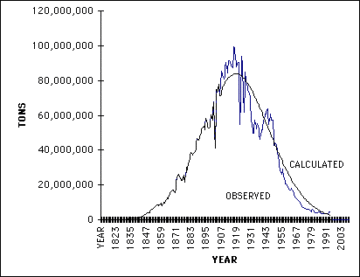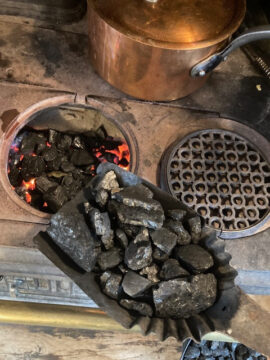by Mike Bendzela

We love our antique coal range. Are we bad people? The answer is easily “Yes,” of course, but it has less to do with our infatuation with the coal range than with our membership in the club of approximately 1.5 billion in the industrialized world. Our utter dependence on the energy-intensive collective economic system of the developed nations makes us pretty damned rapacious, by historical standards. Our individual dependence on the coal range, not so much. The gargantuan footprint of the human enterprise is nothing any of us can do a thing about. Therefore, I say, Gather ye anthracite while ye may.
Why bother with the hassle of such an antiquated heating system? We live in a rambling, restored, 18th century Maine farmhouse with 19th century additions and barn. My spouse, Don, is a retired cabinetmaker and carpenter, an aficionado of 19th century mechanical systems, and an amateur historian of Maine’s rural social life. He bought the stove decades ago and, with the help of a local mason, installed the edifice into the opening of an existing kitchen fireplace. It required mortaring cast iron panels into a pre-built brick infrastructure. The stove thus sits flat against the fireplace wall instead of sticking out into the room like most cast iron stoves.
The original coal grate was burned out, so Don made a pattern of it in carved hardwood and delivered it to a foundry to be cast in iron. Coal grates must be bulky and heavy, as coal burns at a much higher temperature than wood and will destroy a wood grate. Don devised an iron pipe “water back” to go through the firebox and cemented it in place with refractory cement. (The original brass water back was missing.) Water runs through this water back, heats up, and fills the copper-nickel alloy “range boiler” to the left of the stove. From October through May, that is, during the heating season, all the hot water for the house is heated through the coal range. During the hot months we switch on the electric hot water heater and use a propane stove for cooking.
The top of this stove is an ideal cooking surface. The “sweet spot” right over the top of the firebox gets hot enough sometimes to boil a kettle of water in a couple of minutes. The rest of the surface is used for either simmering or warming, depending on how far away from the firebox you move the pot or pan. The interiors of the two ovens above the firebox sit right back into the masonry and are suitable for baking during the heating season. On winter Saturdays, the bean pot–you can see it on the shelf near the top of the stove in the photograph–is in the oven with its load of Maine Yellow Eye beans, spiced molasses sauce, and a chunk of pork. It’s a Maine tradition we enjoy following throughout the winter months (although this season has scarcely felt like winter: the news just arrived that this past February was the hottest on record, following a whole string of warmer-than-normal months).
Thus, the Carpenter brick-set range provides three services in one: space heating, cooking, and hot water. We burn 3 tons of coal (and 5 cords of firewood in a parlor stove) through the long, “cold” months. It used to be far worse: Back in the day, when Don first moved here during the “energy crisis” of the 1970s (and before that coal range was installed), he cut 22 cords of hardwood on the property and burned it in a Glenwood cast iron stove in the kitchen and a Portland Foundry box stove in the back parlor. Snow drifts blew in under the doors, and water regularly froze on the kitchen floor. By the time I moved here in 1985, he had improved the house–pulling out walls and insulating them; replacing large, Victorian window “updates” with smaller, more traditional nine-over-six-pane window sashes–and the fuel requirements had diminished down to 6 tons of coal and 8 cords of firewood. With the total “super-insulation” of the roof and attic several years ago, we have cut our coal and firewood use nearly in half. The owner of the place (we are tenants) plans to install an under-the-floor radiant heating system this year. We’ll continue to use about three tons of coal to cook our meals, heat our hot water, and warm the kitchen to cozy temperatures.
The primary limitation to our consumption of coal is that age-old restraint on the consumer: price. (There is also the hassle of having to schlep all those bags and haul all those ashes.) My father told me that as a kid growing up in Ohio in the 1940s, his family paid 5 dollars a ton for the coal they burned in their cellar furnace. Today, each ton of coal–delivered now on pallets of fifty 40-pound plastic bags, not as a bulk truckload–costs us 500 dollars. That makes it prohibitively expensive for power plants, so it is used mostly in domestic heating. The price has doubled at least in the time (35+ years) that we have been burning it here in Maine. The reason: mineable anthracite is running out. Production peaked at around 100 million tons in 1917, and the US is mining less now (5 million tons) than in 1850. We’re burning basically the tailings in our set range.

Being the highest quality coal there is, anthracite was seized on and burned like crazy throughout the 19th and early 20th centuries. It was the go-to coal for high-temperature processes such as smelting and for powering locomotives. Anthracite is a beautiful thing: it is highly metamorphosed, meaning the original organic matter of which it is composed (lignin from prehistoric trees) was buried deeply and pressure-cooked for a long time, squeezing the water and impurities out of it, bringing it just short of being graphite, over 90% carbon. A lump of anthracite shines like a black jewel, and there is nothing like the popping, crackling sound of the first shovelful of coal being added to a kindling wood fire in the range in October, when the cold sets in and the heating season begins.
*
One of the perks of being an adjunct instructor is that I get to take courses for free at the university where I work. In 2017 I took an evolution course (Biology 217) from the late Professor Kenneth Weber (1943-2023). I do this because I am mad about the subject and have taken every evolution course I can in the Biology and Anthropology departments at school. One of our projects was to “get to know a geological period” by doing a little research and using a wonderful illustrated text called Prehistoric Life: The Definitive Visual History of Life on Earth. I decided to search after the origins of the coal we burn in the range. I titled my little paper “My Journey to the Gzhelian Stage of the Pennsylvanian Sub-Period of the Carboniferous.”
I emailed Kimmel’s Coal of Wiconisco, PA, for information about the origin of the coal we buy, but they did not respond. I used Google Maps to find Wiconisco, which is in Dauphin County, Pennsylvania. A Google search for “Dauphin County PA coal” brought me to the Dauphin County Conservation District’s website and the article “Coal Mining in the Bear Creek and Wiconisco Creek Watersheds.” There I learned that in the past, “underground mining operations [near the Wiconisco Creek watershed] worked more than 20 anthracite beds of the Pottsville and Llewellyn formations.” Googling the names of those formations brought me to the remarkable journal, Fossil Record 4: Bulletin 67, put out by the New Mexico Museum of Natural History and Science. I hit pay dirt there, as it were, with the article “Vertebrate Ichnofossils from Coal Mine Tailings of the Pennsylvanian Llewellyn Formation, Eastern Pennsylvania”:
The sedimentary deposits of the Llewellyn Formation developed in peat-swamps associated with perennial braided rivers of the developing Appalachian foreland basin. . . . The plant biostratigraphy of the Llewellyn Formation indicate a Pennsylvanian age that ranges from the Kasimovian through the Gzhelian, approximately 307 to 300 M[illion years ago]. . .
I didn’t expect to arrive within such a precise 7-million-year window of the Carboniferous Period. The article goes on to the tell the story of Ralph Dupuy Lacoe, a retired financier who became a self-taught paleontologist. He collected fossils associated with various coal mining sites within 100 miles of Wiconisco, PA. His collection of over 100,000 specimens included “trackways” of an early tetrapod! The article even contains photographs of the stone slabs with little footprints in them. What a wondrous journey: the coal we burn was formed from trees growing at a time when the first four-footed animals walked the planet.
The plants of the time–Lycophytes, gigantic club-moss trees, and other flora such as ferns and huge horsetails that grew in coastal swamps–accumulated in peat beds, which were interlayered with alternating sedimentary deposits and over time partially metamorphosed into coal. These forests would have hosted enormous winged insects in the air (dragonflies with 25-inch wingspans), as well as the first spiders, roaches, millipedes and scorpions. It sounds like an amphibian’s paradise. Remarkably, according to the the text of Prehistoric Life, there was a tremendous drop in atmospheric CO2 levels in the coal-forming stages of the Late Carboniferous. One wonders whether the earlier “greenhouse” world which had given rise to the huge forests didn’t collapse all at once after all the carbon had become sequestered in those coal beds . . . which over 300 million years later would be rapidly, avidly, and impetuously mined by energy-hungry Pennsylvanians . . .
*
And what about that carbon? You’re helping to release all that prehistoric carbon right back into the atmosphere, possibly recreating the conditions under which those Lycophyte forests grew!

I have pondered this question obsessively. Carbon dioxide molecules are the same, no matter whether they come from coal, oil, gas or animal respiration. I’m aware of the different isotopes of carbon: carbon produced from fossil and living organisms has a different isotopic “fingerprint” than that produced by volcanoes. But in terms of their greenhouse activity, they’re the same. Anthracite coal–almost all of it from Pennsylvania and Wales–is especially carbon dense; that makes it the richest, most efficient of the coals, burning with a hot, steady flame that is most comforting and easy to tend: Shut down for the night, our range can go twelve hours or more before it has to be tended. I’m turned off by the term “clean coal,” but anthracite is the “cleanest” of all the coals in that it has fewer impurities than lower grade coals such as bituminous, sub-bituminous, and lignite, which comprise most the the 8.5 billion tons! of coal burned worldwide per year.
Grappling with this gargantuan carbon problem is nauseating. In spite of newer, “alternative” energy sources always coming online, we never replace the use of existing sources, as geologist Art Berman explains: We simply add on top of them, like the layers of a cake. Actual biomass use and hydro power capacity have not declined in spite of the onset of the fossil fuels, only as a percentage of the whole. Actual fossil fuel use has not declined in spite of the onset of nuclear and “alternative” sources; it has just diminished slightly as a proportion of total energy used. Meanwhile, we grow and consume and continue carrying on like yeasts in a carboy of cider.
I decided to calculate our “carbon footprint,” expecting to be horrified. I was, but only moderately so. I first discovered that the online “carbon footprint calculators” are a mess. They ask different questions and cough up varying footprints. Most of them do not have a space to enter “anthracite coal”–or sometimes even “hardwood”–as a household heating source. The one useful site I did find, carbonfootprint.com, did have a spot for home coal use, but I had to fudge the firewood component by entering “6 tons of wood pellets” to approximate the weight of 5 cords of dry, seasoned, mixed hardwood. The calculated footprint for “household” was fairly precise, as I have all the receipts for our purchases of coal, firewood, propane, and electricity. Rounded up slightly, it comes out to be 5 tons per our two-person household. Figuring out the footprint for our single vehicle (a 2018 Nissan Frontier) was pretty straightforward as well, for we put about 9000 miles on it last year, giving a shocking 4 tons for a footprint. But there was no way to figure in the use of gasoline for lawn mowing: During my summer job, I mow a 5-acre cemetery approximately 7 times per year; and we have a one-acre apple orchard here on the farm to keep mowed.
Lots of categories got zeroes: air flights, public transport, and motorcycles; hotels and restaurants; television, recreation, sports. . . . Things became really dicey, though, when it came to calculating “secondary” sources of carbon, namely all the ways we run our household. They ask for the costs of “food and drink products of an average meat eater.” Besides not really knowing the answer, I was unsure whether raising all of our own pork offset or added to our footprint. (A delivery truck brings sacks feed to the farm.) How about that half a cow we bought from a neighbor up the road? Does that offset some of the carbon of being “the average meat eater,” or not? What about growing and storing about 25% of our own bulk vegetables? And processing and preparing all our meals at home? Why do they need to know our mortgage and loan interest payments? My cell phone adds approximately .14 metric tons of carbon to our footprint. So I am told.

Our total–and most certainly incorrect–carbon footprint came out to be just shy of 12 tons. Even if I fudge it and add a ton, thirteen tons is still significantly lower than the approximately 15-and-a-quarter-tons average for persons in the United States. This in spite of living in cold northern New England and burning coal.
But our footprint is significantly higher than the EU average of 6.8 tons. And it is obscenely higher than the worldwide average of 4.8 tons. Nearly three times as high, in fact. How accurate can we be with such footprints?
When you begin looking at the numbers, the pernicious bullshit of personal carbon footprint calculators becomes clear. We are all entangled, in one way or another, in the vast industrial system of the West, whose fossil energy needs are beyond comprehension. I learned the term entanglement in a course called Origins of Mediterranean Civilizations to 750 CE, taught by a delightfully crabby Texan who has since retired. We read from the book Entangled: An Archaeology of the Relationships between Humans and Things by Ian Hodder, who has spent most of his career excavating the Neolithic settlement of Çatalhöyük in central Turkey. He shows us how humans’ identities are as tied up in the material cultures into which they are born as they are in the physical facts of their anatomies. You learn as much about people by examining their stone tools as by examining the stable isotopes in their teeth.
If you just look around at the world we live in, there is fossil carbon everywhere. Energy and environmental scholar Vaclav Smil rubs our faces in our collective carbon energy entanglement in his book How the World Really Works. He reminds us
that the “four pillars of modern civilization,” “cement, steel, plastics, and ammonia [fertilizer]” are just vast expressions of our coal mines and our gas and oil wells, making our individual carbon footprints seem quaint. It brings into question the whole concept of “alternative energy.” Just think: without steel, concrete, and plastic, there would be no wind turbines and electric vehicles; and without ammonia-based fertilizers, there would be no workers to change the batteries! “Green,” my ass! We are as shot through with fossil carbon as we are with the organic molecules of our physical composition.
*
What is the carbon footprint of raising five cats, twenty-four chickens, and a smattering of turkeys, including veterinary care and commercial feed?
What is the carbon footprint of the 10 types of imported bulk teas we have delivered to the house every year?
What is the carbon footprint of a year’s worth of our dental work–fillings, root canals, partials and all? Of Don’s thirty-five radiation treatments for acinic cell carcinoma? Of the sophisticated plastic medical devices he has delivered to our doorstep monthly to monitor his diabetes?
What is the carbon footprint of the computers I spend time on preparing student assignments and reading and grading their work? Of the energy embedded in the construction and materials of my banjo and two fiddles?
World population grows by close to a quarter of a million people a day, swamping any pretense we may have of “offsetting” carbon with our personal choices. So, like the last tailings of Pennsylvania’s anthracite mines vanishing into our kitchen range, we can pretty much count on the world’s vast stores of oil and natural gas all going up in smoke.
_____________________
Images
Photographs by the author unless otherwise noted.
